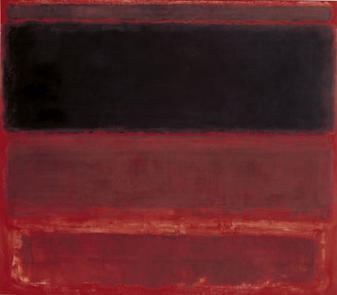Appreciating art was something I wasn't always good about, it all came to me over these years as I went about studying artists and architects alike. But there's this thing around which I couldn't just wrap my head, abstract art. There's this guy named Mark Rothko who is into abstract expressionism. For instance, here's one of Rothko's works, Four Darks in Red (1958).
So, while one of my friends back at my university, School of Planning and Architecture, went about singing praises on how deep a meaning his works hold and how some of them are valued at millions (one of his work was sold for $87 million), I asked myself,
While we waited in the metro, where the breeziness of air conditioned gusts flowed freely, my friend tried his best to convince me that abstract art can be though of as a stage or a level, and isn't a stage or a level that you can reach when you're just starting out in the field of art, because that's when you'd be testing the waters, and also that's when you're just naive. What made Rothko's work stand out were the fact that they were created by Rothko, because years of exploration has made him achieve a level on which you and me aren't at yet.
He even beautifully quoted Picasso!
Our brain is terribly wired. It forces me to look for forms even when I know I was looking at an abstract art, and so I could see dark patches in his work, which looked almost like spots in his paintings. On inquiring him, he said that they weren't intentional. It's just something that he had in his personality that he later found being transcended into his art. And that's when it struck me.
Beyond the abstraction of the celestial that he consciously wanted to portray, beyond the romance of day and night that he witnessed in the skies, there was a sub-conscious that sneakily made its way into his art forms, and that is what forms the aura of the whole artwork. And also that's the reason why I can't paint a square swatch and sell it for potentially millions, because as of now, my personality cannot descend into my work, it'll only comes with years of exploration.
I couldn't really have learnt this if I hadn't had the chance to see the artist and his works together. I asked him to pose against his favorite work, the one which he felt himself the most attached to, and it was this:
I'm grateful to Vandana Kothari Ma'am for this enlightening lesson and the wonderful insight that came with it.
So, while one of my friends back at my university, School of Planning and Architecture, went about singing praises on how deep a meaning his works hold and how some of them are valued at millions (one of his work was sold for $87 million), I asked myself,
Isn't this something I can do, too? Or, for that matter, we all can, too? What actually is abstract art after all, painting swatches?This was all happening while we're huddled together in a metro train slithering its way through the subways of the city while we're on our way to an art exhibition at Gallery Threshold (hosted by Ms. Tunty Chauhan) displaying Pandit Khairnar's works which were critiqued by Georgina Maddox.
While we waited in the metro, where the breeziness of air conditioned gusts flowed freely, my friend tried his best to convince me that abstract art can be though of as a stage or a level, and isn't a stage or a level that you can reach when you're just starting out in the field of art, because that's when you'd be testing the waters, and also that's when you're just naive. What made Rothko's work stand out were the fact that they were created by Rothko, because years of exploration has made him achieve a level on which you and me aren't at yet.
He even beautifully quoted Picasso!
There is no abstract art. You must always start with something. Afterward you can remove all traces of reality.We reached where there was a hall, the walls of which proudly displayed works of Khairnar, and while I meditatively tried to engage in a conversation with the works of his abstractness, Pandit Khairnar stood there besides me, albeit silently and still, and it was his works which did all the talking.
Our brain is terribly wired. It forces me to look for forms even when I know I was looking at an abstract art, and so I could see dark patches in his work, which looked almost like spots in his paintings. On inquiring him, he said that they weren't intentional. It's just something that he had in his personality that he later found being transcended into his art. And that's when it struck me.
Beyond the abstraction of the celestial that he consciously wanted to portray, beyond the romance of day and night that he witnessed in the skies, there was a sub-conscious that sneakily made its way into his art forms, and that is what forms the aura of the whole artwork. And also that's the reason why I can't paint a square swatch and sell it for potentially millions, because as of now, my personality cannot descend into my work, it'll only comes with years of exploration.
I couldn't really have learnt this if I hadn't had the chance to see the artist and his works together. I asked him to pose against his favorite work, the one which he felt himself the most attached to, and it was this:
I'm grateful to Vandana Kothari Ma'am for this enlightening lesson and the wonderful insight that came with it.




Post a Comment